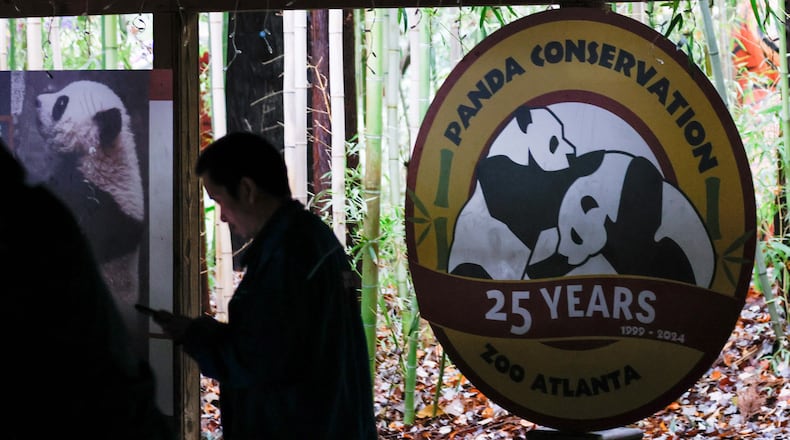During the Halloween-themed Boo at the Zoo Atlanta festivities in late October, kids played Panda Plinko for prizes and gleefully posed with a person dressed as a panda. The Panda Pagoda gift shop sold stacks of stuffed pandas for $25.
But actual giant pandas were no longer there. Lun Lun and Yang Yang had returned to China two weeks earlier with their two offspring, Xi Lun and Ya Lun. The entrance to the exhibit was closed off, a bright yellow sign thanking patrons for their support with a link to a “panda legacy” website.
This is a major juncture for Zoo Atlanta, the first time in a quarter century it’s operating without beloved black and white pandas. They were reliable tourist and fundraising magnets. Panda related souvenirs accounted for half the zoo’s merchandise sales.
Credit: RODNEY HO/rho@
Credit: RODNEY HO/rho@
“Pandas have a unique status,” said Raymond King, Zoo Atlanta’s chief executive officer since 2010. “People come from all over the country to see those pandas. I think it’s something about them. You want to cuddle them. Even watching them eat is entertaining.”
But the 40-acre zoo has been preparing for their departure for many years. The pandas were on a long-term lease from China, a deal renewed multiple times. But China likes to bring pandas back when they reach elderly status. Both 27 years old, Lun Lun and Yang Yang qualified. Their two 8-year-old kids, Ya Lun and Xi Lun, also took the flight on Oct. 12 to the Chengdu Research Base of Giant Panda Breeding where they are adjusting to life in their new home.
Fortunately, Zoo Atlanta is arguably in its strongest financial shape in its 135-year history. Last year, the zoo generated a record $46.3 million in revenue with expenses of just $31.7 million. Its 5-year-old African Savanna environment for elephants to roam has been a major hit with attendees. The former Cyclorama building, converted into Savanna Hall, an elegant event space with sweeping views of the zoo grounds, has become a hot draw for corporate banquets, fundraisers and weddings. A much needed $20 million state-of-the-artanimal medical center just opened with a $250,000 CAT scanner, and apartments have been constructed to provide living quarters for veterinary interns.
In the past 15 years, more than half the zoo has been renovated or heavily transformed.
“They are now a dynamic attraction,” said William Pate, president and CEO of Atlanta Convention & Visitors Bureau and a lifelong Atlantan who has been attending the zoo for six decades. “They’re constantly adding new exhibits that draw new visitors and return visitors.”
Added Dan Ashe, president of the Association of Zoos and Aquariums (AZA), who grew up in Atlanta: “It’s the same physical space as the Grant Park Zoo of my childhood but completely different.”
A happy accident
Zoo Atlanta came to be by pure happenstance. A traveling circus ran out of cash when it came to Atlanta in 1889 and local business owner George V. Gress bought out the entire menagerie, which included a jaguar, a hyena, a black bear, a raccoon, an elk, a gazelle, a Mexican hog, lionesses, pumas, camels and snakes.
In 1935, Asa G. Candler Jr., the eccentric son of Coca-Cola magnate Asa Candler, donated most of his collection of exotic animals after his neighbors in North Druid Hills complained of the noise and odor. That gave the Grant Park Zoo its first tiger, named Jimmie Walker, along with elephants, leopards, water buffalo and elk, among other species.
The city-owned zoo struggled to find its footing over the decades. In 1947, the director of the Atlanta Humane Society called the zoo a “disgrace to the city.” In 1957, zoo officials surmised that a swan, a gift from the Swiss government, had been clubbed to death by kids.
Credit: AJC FILE PHOTO
Credit: AJC FILE PHOTO
Two years after a primate house opened, a baby gorilla, dubbed Willie B. after Atlanta mayor William B. Hartsfield, arrived in 1961. He soon became the zoo’s signature resident. But the 6-foot tall, 400-pound lowland gorilla lived a lonely life in a concrete caged cell for 27 years. “It was a classic zoo of its time,” Ashe said. “Willie B. had a TV, a tree swing, no enrichment, no naturalistic qualities to allow a gorilla to be a gorilla.”
In the 1970s and early ‘80s, the zoo suffered from tepid attendance, excessive animal deaths and management turnover, leading Parade magazine to deem it one of the 10 worst zoos in the nation. The zoo’s membership with the AZA (then called the American Society of Zoological Parks and Aquariums) was temporarily suspended.
Credit: AJC
Credit: AJC
Mayor Andrew Young assembled an emergency crisis team to address this civic black eye, appointing Terry Maple as interim director and creating an independent nonprofit agency to operate what was now called Zoo Atlanta for the city of Atlanta and Fulton County. Maple, a Georgia Tech psychologist specializing in primate studies, helped bring the zoo back from the brink.
In a symbolic shift in the way Zoo Atlanta handled animals, Willie B. in 1988 was moved from his cage to a naturalistic outdoor rain forest habitat sponsored by Ford Motor Co. He proceeded to sire five children, four of whom are still at Zoo Atlanta, and lived 12 more years around other gorillas. His funeral drew 5,000 people and a eulogy from Young. “We were moved to set him free, and perhaps in so doing we set ourselves free,” Young said in 2000. “And could learn that we can all live together with all the animals that God created.”
Willie B.’s legacy lives on outside the gorilla house in a life-size bronze statue containing 90% of his ashes. Today, Zoo Atlanta has the largest collection of gorillas in North America at 19.
Credit: AJC
Credit: AJC
Credit: KIMBERLY SMITH
Credit: KIMBERLY SMITH
Maple’s approach to the zoo was to promote iconic species that would attract attention and visitors like apes, orangutans, reptiles and, of course, gorillas.
“Terry had a commitment to the well-being of the individual animals,” said Ashe, whose organization recently gave Maple a posthumous lifetime achievement award. “He connected the zoo to science and conservation. It became a much more vibrant organization. Zoo Atlanta now gets high marks and has been continuously accredited since Terry was there.”
Panda-monium
Maple had one more trick up his sleeve before he retired from Zoo Atlanta in 2003. He engineered an audacious deal to get giant pandas.
At the time, only the San Diego Zoo had pandas in America. Maple promised China strong research and education components through Georgia Tech, the University of Georgia and other institutions.
“He built an unlikely coalition of Jimmy Carter, Andrew Young and Newt Gingrich that I believe was instrumental in tipping the balance for the zoo to get them,” said Maples’ successor Dennis Kelly, the zoo’s chief executive from 2003 to 2009.
In 1999, Lun Lun and Yang Yang arrived in Atlanta from Chengdu on a special UPS plane dubbed the “Panda Express.” They were given a police escort for the 10-mile trek from the airport to the zoo.
“Fire engines gave them a water salute,” said Rebecca Snyder, senior director of conservation, education and science at Oklahoma City Zoo and Botanical Garden, who worked at Zoo Atlanta until 2014.
A scientist who studied panda behavior in China and witnessed Yang Yang’s birth in 1997, Snyder recalled the pandas arrival: “Yang Yang’s face popped up in the crate and I couldn’t have been more excited.”
The pandas became an immediate sensation. A million people, by far a record, came to the zoo in 2000. Many more all over the world watched the pandas over the years on a panda cam. Lun Lun and Yang Yang bred seven children, creating buzz each time babies were born. (Five of their offspring went back to China once they reached breeding age.) And the zoo gave China $17 million over 25 years while providing fresh research on panda behavior such as mother-cub relationships.
Credit: Jenni Girtman for the AJC
Credit: Jenni Girtman for the AJC
But the zoo continued to struggle financially even with the pandas.
“The zoo had everything it needed except a business perspective,” said Kelly, a former chief marketing officer in Europe for Coca-Cola. “It had the science. It had the research. It had the conservation. What it didn’t have was the discipline that comes from running a complex organization.”
When Kelly took over, the zoo’s debt load was a whopping $19.5 million. He convinced the city of Atlanta to fund a bond to reduce some of that debt and big Atlanta philanthropic foundations like the Woodruff Foundation and J. Bulow Campbell Foundation to provide more support.
“They were beginning to lose faith in us,” Kelly said. “I had to reestablish those ties.”
The zoo, constrained by limited acreage, considered moving to the larger Lakewood Fairgrounds in 2007 but nixed the idea as too pricey.
By the time Kelly left in 2009, he was able to clear all of the zoo’s debt, positioning the organization for growth. He was also able to cut the annual contribution to China for keeping the pandas in half to $570,000, down from $1.1 million.
Enter King, a business executive who had spent years cultivating relationships as the head of SunTrust Banks community affairs. He was able to mine those connections to rev up donations.
“He is an excellent fundraiser,” Pate said. “He has great credibility with the fundraising community. He is also a great visionary who laid out a solid plan for the zoo. He makes you want to support the zoo.”
King had to find ways to build attendance.
“It’s a pretty high fixed-cost business, a very capital intensive business,” King said. “We had plateaued at 650,000 visitors a year. That wasn’t enough to make it work.”
In 2015, the zoo opened a new $19 million reptile center dubbed Scaly Slimy Spectacular that housed 70 species including a Cuban crocodile, an eastern diamondback rattlesnake and the black mamba under a 45-foot-high glass dome.
Then the zoo capitalized on the departure of the city-owned Atlanta Cyclorama, home to a 138-year-old, cylindrical depiction of the 1864 Battle of Atlanta that had been a longtime awkward neighbor of the zoo. That tourist attraction moved to the Atlanta History Center in 2017, enabling the zoo to take over the building as an event space and build out its African Savanna exhibit for the zoo’s three elephants at a cost of $55 million.
“I’m a believer that financial strength creates opportunity,” King said.
Another longtime frustration for the zoo was a lack of adequate parking, which deterred visitors on busy weekends. The city helped fund the installation of a $48 million, 1,000-seat parking deck adjacent to the zoo, which opened in 2021.
Michelle Blackmon, who runs the Grant Park Nature Conservancy, said the deck has worked well for both the zoo and the neighborhood. “The green space on top is a really special spot overlooking the elephants and giraffes,” she said. “It stays busy with folks picnicking, roller skating and children learning how to ride their bikes.”
Credit: Kelly Klein and the Grant Park Conservancy
Credit: Kelly Klein and the Grant Park Conservancy
Credit: John Spink
Credit: John Spink
Five years ago zoo leaders anticipated attendance would broach 1 million by 2024, but the pandemic handicapped efforts to reach that goal, said Kerry Stewart, who runs the Atlanta Fulton County Recreation Authority, which owns the zoo via a long-term agreement with the city and Zoo Atlanta but keeps a largely hands-off relationship with management.
Nonetheless, 2024 has been a good year for Zoo Atlanta, with attendance outpacing last year’s 950,000, boosted by good weather and the hoopla over the panda’s departure.
The zoo is also attempting to compete with the Atlanta Botanical Garden’s popular “Garden Lights, Holiday Nights” program with its own IllumiNights evening lantern festival, now in its third year featuring illuminated lanterns shaped like cheetahs, giraffes, tigers, pandas and more through Jan. 19. And a new lion exhibit with better sight lines is being built funded entirely with the zoo’s existing savings.
Stewart said he anticipates a short-term loss in attendance in 2025 due to the pandas’ departure, but he is confident the zoo is prepared to weather it.
“It’s a big unknown,” King said. “But it’s not the death knell for the zoo. I think maybe 10% might stop coming because they aren’t here. Time will tell. They drive a lot of areas of revenue, but they are also very expensive animals to take care of. Net, net, we’ll see how it settles out.”
Now the question is whether Zoo Atlanta will ever get pandas again. It’s a delicate dance between zoo and Chinese officials, colored in part by global politics that are out of the zoo’s control.
“The Chinese government certainly sees lending pandas as a gesture of goodwill,” said Snyder. “The relationship between the two countries have to be friendly for panda loans to work.”
Indeed, for a time last year, Zoo Atlanta was the only zoo in America to have pandas when relations between the two countries turned chilly. But in a positive sign, China this year has given new pandas to both the San Diego Zoo, which waited five years between pandas, and the National Zoo in Washington, D.C., which recently welcomed two pandas after an 18-month absence.
“Zoo Atlanta is well positioned to get new pandas,” Snyder said. “They have an excellent record of producing cubs and taking care of pandas. It will take time to work through the negotiations.”
King doesn’t disagree: “We’re still looking forward to a future with pandas.”
Credit: Miguel Martinez-Jimenez
Credit: Miguel Martinez-Jimenez
IF YOU GO
Zoo Atlanta. 9 a.m.-3:30 p.m. daily. $23-$28; $129 annual membership. IllumiNights, 5:30-9:30 p.m. through Jan. 19. $21-$25. 800 Cherokee Ave. SE, Atlanta. www.zooatlanta.org
Keep Reading
The Latest
Featured













